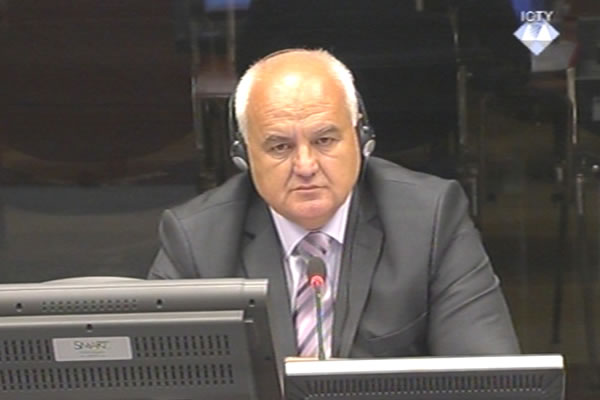Home
‘AMBIENT CONDITIONS’ CAUSED NON-SERBS TO EVACUATE
Karadzic’s military expert Dragomir Keserovic doesn’t think that the Republika Srpska authorities systematically expelled non-Serbs from the areas Serbs considered as part of their territory. In Keserovic’s opinion, the process was a result of ‘general ambient conditions’: the fighting and a dire economic situation. According to Keserovic, ‘all those who had a place to go and seek shelter’, left voluntarily
 Dragomir Keserović, defence witness of Radovan Karadzic
Dragomir Keserović, defence witness of Radovan Karadzic Radovan Karadzic’s defense case continued with the evidence of General Dragomir Keserovic. In his report as a military expert, Keserovic refuted the findings of Ewan Brown, the prosecution’s military expert. Based on the documents of the VRS 1st Krajina Corps Brown concluded in his report that the first strategic goal – the separation of Serbs from Muslims and Croats in BH – was of crucial importance for the Bosnian Serb political and military leadership. The goal was implemented through the expulsion of non-Serbs from the Republika Srpska territory. Using the same documents, Karadzic’s expert reached diametrically opposite conclusions.
According to Keserovic, the reports and the orders of the 1st Krajina Corps don’t indicate at all that there was any forcible transfer of the population, least of all ethnic cleansing. On the contrary, the documents ‘consistently and continuously’ stress that the corps command was opposed to the moving out of the non-Serbs. The documents call for the protection of the civilian population and the treatment of the detainees in line with Geneva conventions. Instead of taking that into consideration, Brown gave too much weight to the crimes in the field and thus reached the wrong conclusion: that the corps tolerated the crimes against the non-Serbs.
Keserovic didn’t deny that there were crimes but ascribed them to ‘irresponsible individuals’. Keserovic didn’t contest the fact that some politicians from Republika Srpska and the so-called Autonomous Region of Krajina expressed ‘extremist views’ but that was not the official policy. Keserovic claimed that the crimes and public displays of extremism didn’t cause non-Serbs to leave Krajina. In Keserovic’s view, they left because of the ‘general ambient conditions’ of the war. In other words, the population feared the fighting on the one hand, and on the other, the economic future was uncertain and ‘all those who had a place to go and seek shelter’ left voluntarily.
The 1st Krajina Corps did everything to protect the non-Serb civilians, taking measures to prevent crimes and punish perpetrators, Keserovic argued, going as far as moving whole units from the frontlines into the depth of the territory to protect the non-Serb civilians, even at the expense of diminishing the combat strength of the Bosnian Serb army. Keserovic brought up Karadzic’s order to protect religious facilities belonging to all confessions because they were part of Republika Srpska’s national heritage.
In a bid to play down the responsibility of the Pale leadership for the events in Krajina, the witness said that there was discord and animosity between them and the leaders of the Autonomous Region of Krajina. As Keserovic also noted, the telephone lines and other forms of communication were often disrupted. This situation continued until September 1992 when the Autonomous Region of Krajina was abolished.
Today Karadzic completed the examination of his expert Dragomir Keserovic. Keserovic’s cross-examination was delayed until 23 July 2013 to allow the prosecutor additional time for preparation because of the changes in the witness schedule. The trial of the former Bosnian Serb president for genocide and other crimes in BH continues tomorrow with the evidence of new defense witnesses.Linked Reports
- Case : Karadzic
- 2013-07-05 AWARDS HANDED TO WRONG PEOPLE
- 2013-07-03 DENYING CRIME AT JADAR RIVER BANK
- 2013-07-02 POLICE GENERAL HAD NO AUTHORITY VIS-À-VIS CRIMES
- 2013-07-09 KARADZIC RECYCLES KRAJISNIK’S FAILED ARGUMENT
- 2013-07-10 WHAT ‘GOD-FEARING’ PRESIDENT KNEW ABOUT SREBRENICA
- 2013-07-11 GENOCIDE CHARGE AGAINST KARADZIC REINSTATED
